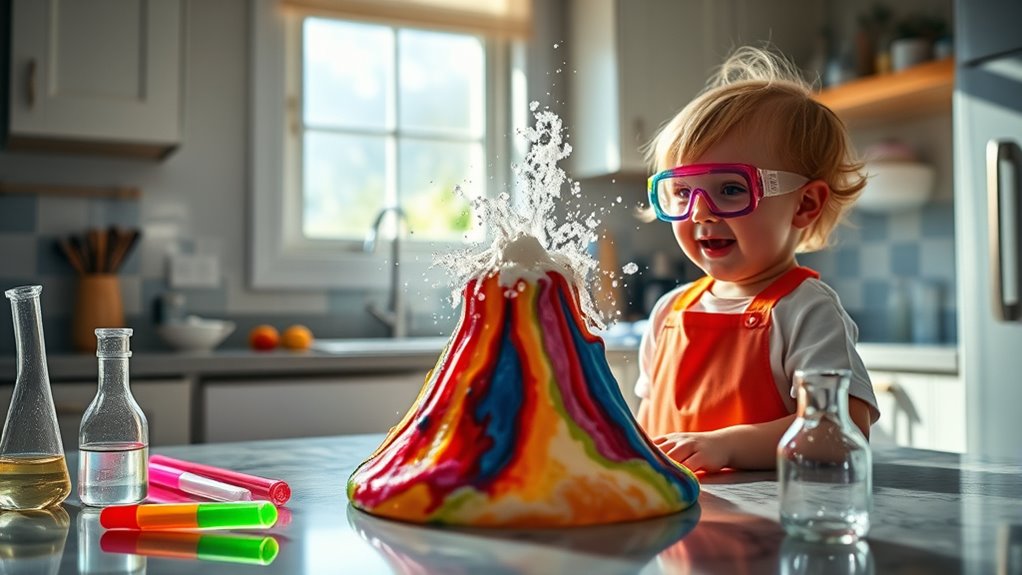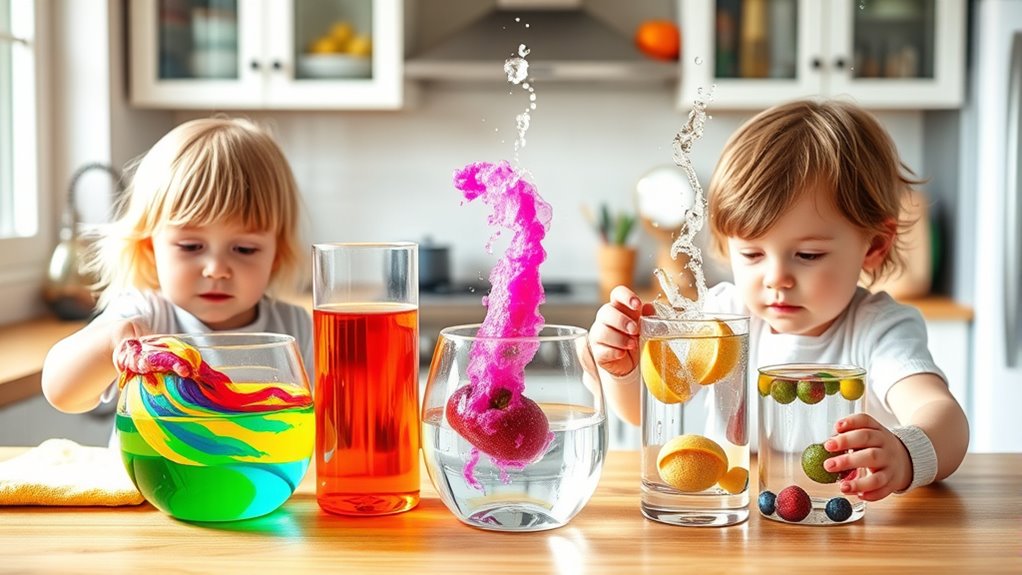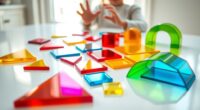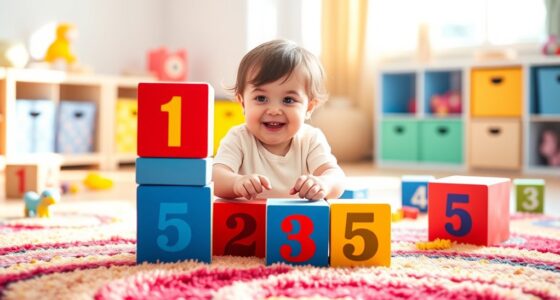Discover five safe and fun kitchen experiments that will wow your toddler and spark their curiosity. Try mixing food coloring with baking soda and vinegar for colorful fizzing reactions, helping them see cause and effect in action. You can also explore simple activities like dissolving sugar or observing melting ice to teach basic science concepts. These engaging activities are quick, safe, and easy to set up. Keep exploring to learn more about turning everyday kitchen moments into learning adventures.
Key Takeaways
- Use simple ingredients like baking soda, vinegar, and food coloring for safe, engaging reactions.
- Conduct experiments in small, controlled amounts to ensure safety and easy supervision.
- Incorporate visual elements like colorful food coloring to captivate and educate toddlers.
- Encourage hands-on participation to foster curiosity and reinforce cause-and-effect understanding.
- Keep activities quick and straightforward to maintain toddler interest and promote early scientific learning.

Have you ever wondered how everyday kitchen activities involve science? It’s fascinating to realize that simple tasks like baking, mixing, and even cleaning are rooted in scientific principles. When you involve your toddler in safe experiments, you not only entertain but also introduce them to the wonders of science right in your own kitchen. For example, using food coloring and baking soda can create mesmerizing reactions that capture their curiosity and make learning fun. These activities are easy to set up, safe, and perfect for little hands enthusiastic to explore.
Imagine adding a few drops of vibrant food coloring into a shallow dish of baking soda. As you pour vinegar over the mixture, a fizzy, colorful eruption occurs. Your toddler’s eyes will light up as bright bubbles overflow, demonstrating a simple acid-base reaction. This visual spectacle helps them understand basic chemical reactions in a tangible way. The food coloring adds an extra layer of excitement, turning an ordinary kitchen ingredient into a colorful display. It’s a safe way to introduce concepts like reactions and changes in states of matter without any mess or danger.
You can also turn this experiment into a playful game by letting your toddler choose the colors and help sprinkle the baking soda into the dish. As soon as you pour the vinegar, they’ll see the reaction happen instantly, which reinforces the idea of cause and effect. You can explain that baking soda is a special kind of powder that reacts with acids like vinegar, producing carbon dioxide gas—that’s what makes the bubbles. The food coloring makes the reaction more visually appealing, helping your little one connect the science to what they see and experience.
Turn your toddler into a little scientist by letting them choose colors and sprinkle baking soda for a fun reaction!
This simple experiment is just the beginning. You can explore different colors, add more baking soda for bigger reactions, or even try other acids like lemon juice. All these activities are safe, quick, and require minimal supervision—perfect for engaging young minds. Plus, they’re great opportunities to teach your toddler about measurements, colors, and reactions, sparking their natural curiosity. Remember, the goal is to keep it fun and educational, letting your child ask questions and discover new things. Whether you’re making a rainbow of fizz or just exploring how substances interact, these kitchen science activities help foster a love of learning that can last a lifetime. Incorporating sound principles of sound design like clarity and engagement can make these activities even more memorable and enjoyable.
Frequently Asked Questions
Are Kitchen Science Experiments Safe for All Toddlers?
You might wonder if kitchen science experiments are safe for all toddlers. While they can be fun and educational, you should prioritize cooking safety and allergy awareness. Always supervise your child closely, avoid using hazardous materials, and check for any allergies to ingredients involved. Tailor activities to your toddler’s age and abilities, ensuring a safe environment. With proper precautions, you can enjoy safe, engaging science experiments together.
How to Prepare a Toddler-Proof Science Experiment Setup?
Imagine setting up a simple volcano experiment with baking soda and vinegar. To prepare a toddler-proof setup, use non-toxic materials and secure all items out of reach. Always supervise closely, keeping your child engaged and safe. Cover surfaces with a towel or tray to catch spills, and explain safety rules beforehand. These supervision tips and non-toxic choices guarantee your little scientist explores safely and happily.
What Age Is Appropriate for Toddler Science Experiments?
You should consider age considerations and developmental milestones when choosing science experiments for your toddler. Typically, children around 12 to 36 months are ready for simple, safe activities that stimulate curiosity and motor skills. Keep experiments age-appropriate, focusing on sensory exploration and basic cause-and-effect concepts. By aligning activities with your child’s developmental stage, you make sure they stay engaged, safe, and excited to learn through hands-on discovery.
Can Kitchen Science Help With Toddler Developmental Skills?
Imagine a small hand carefully pouring water into a cup; kitchen science sparks your child’s sensory exploration and fine motor skills. These activities help your toddler develop coordination, curiosity, and understanding of cause and effect. As they grasp, pour, and observe, you’re fostering vital developmental skills naturally. Engaging in safe kitchen experiments turns everyday moments into fun learning opportunities that boost their growth while creating joyful memories together.
How to Clean up After Toddler Science Experiments Safely?
To clean up after toddler science experiments, follow simple cleaning tips and safety precautions. Wear gloves if necessary, and use non-toxic cleaning supplies. Immediately wipe down surfaces with a damp cloth to prevent stains or residue. Dispose of any waste properly, and wash your hands thoroughly afterward. This guarantees a safe, clean environment, making future experiments enjoyable and stress-free for both you and your toddler.
Conclusion
Now that you’ve explored these fun and safe kitchen experiments, you’re ready to amaze your toddler with science. Imagine showing them how baking soda reacts with vinegar, creating a mini volcano right on the countertop. Not only will they be delighted, but you’ll also be fostering their curiosity and love for learning. So, grab your ingredients and start experimenting—you’re turning your kitchen into a science playground that sparks wonder and discovery!










